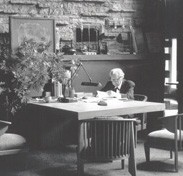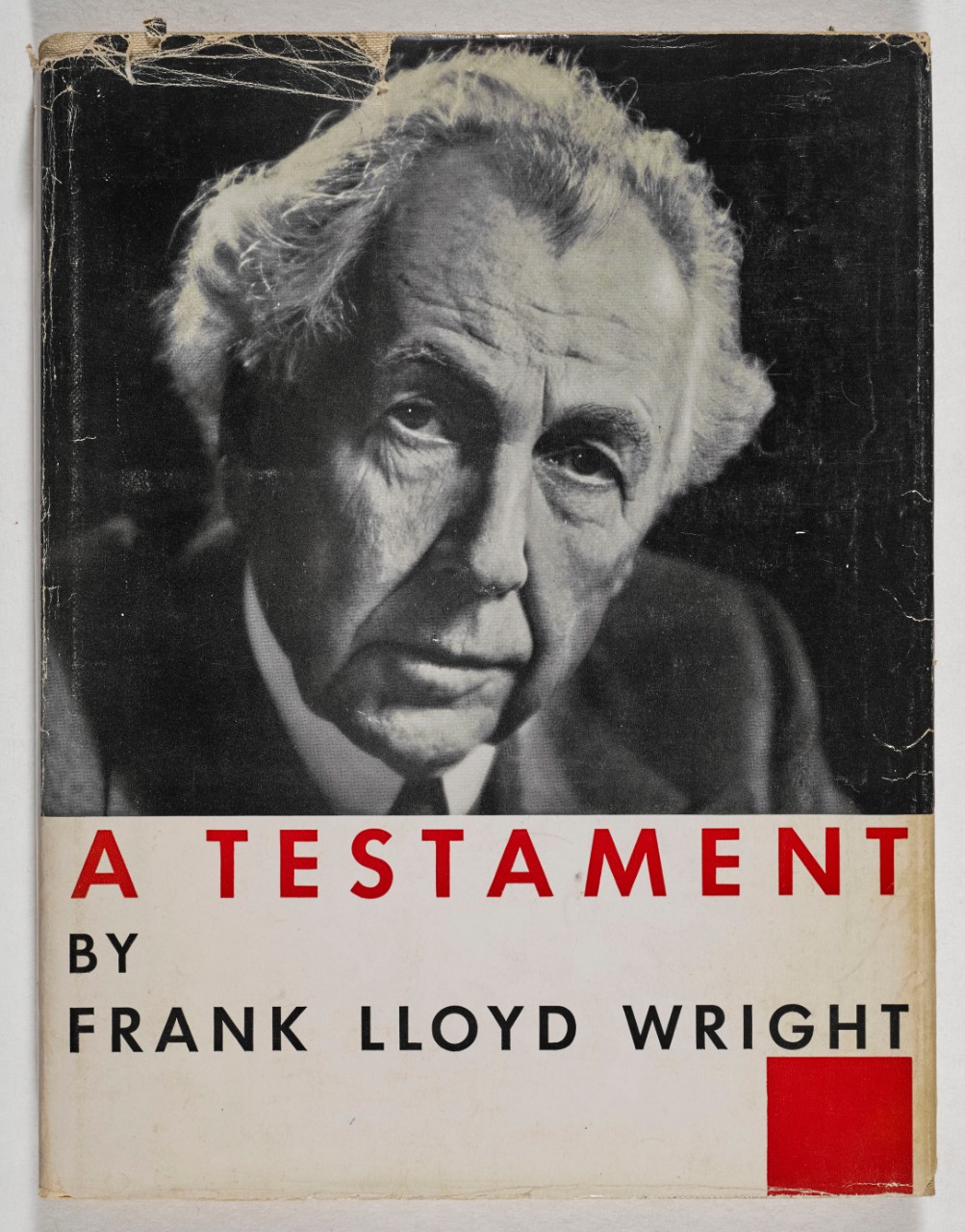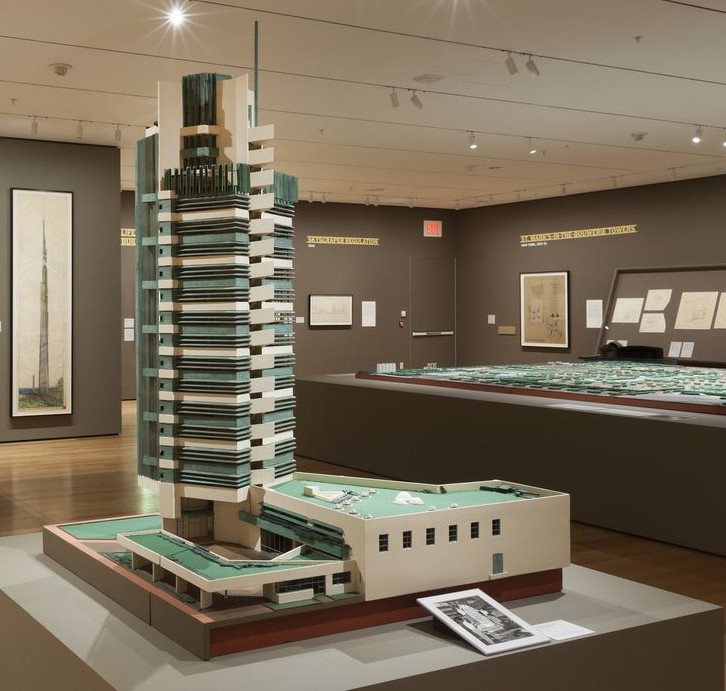About Wright at Avery
Introduction

Frank Lloyd Wright (1867-1959) has been recognized by the American Institute of Architects as "the greatest American architect of all time" and throughout its distinguished history, Avery Library has comprehensively collected published works by and about Wright as well as archival materials on Wright, his influencers and protégés.
Frank Lloyd Wright’s architecture practice was established in 1893, nearly coincident with the founding of Avery Library in 1890. In 1894, Wright delivered his first public lecture, “The Architect and the Machine,” at the Architectural League of America in Chicago and, in their first published form, Wright’s words entered Avery Library’s collection as “The Architect” in the September 1900 issue of The Brickbuilder. Now, more than one hundred years later, the manuscript for that lecture and thousands of other Wright primary documents join Avery’s comprehensive collection of Wright’s bibliography. Avery’s Wright holdings include more than 1,200 books by and about Wright in the general collections and more than 200 rare Wright editions, including House Beautiful (1896 –[1898]), Ausgeführte Bauten und Entwürfe (1910 and subsequent editions), and The Japanese Print (1912). In addition, the Avery Classics collection holds 50 books from his son John Lloyd Wright’s library and 116 volumes of Wright’s own copies of his published works, many annotated and inscribed, including An Autobiography (1943) and his last written work, the preamble to the proposed book The Wonderful World of Architecture, published posthumously in Architecture: Man in Possession of His Earth (1962).
Similarly, the Avery Index to Architectural Periodicals traces articles authored by and about Wright; the preponderance of interest in Wright is notable with more than 3,300 entries in twenty languages. In comparison to articles by and about his peers—early contemporaries such as McKim, Mead & White, his fellow modernist Le Corbusier, or form-shaping architects of our times such as Frank Gehry—more journal articles are written and indexed about Wright than any other architect.
The Wright bibliography —monographic and serial publications—is consulted side-by-side with the architectural records held in the Avery Drawings and Archives collections. Creative and critical lines of thought stretch across Avery’s archival holdings, connecting Wright to the papers of closely associated architects, historians, and critics including Henry-Russell Hitchcock, Douglas Putnam Haskell, Louis Sullivan, Edgar J. Kaufmann, Philip Johnson, and Edgar Tafel, each offering comment on Wright or including drawings and documents authored or drawn by Wright himself. From Avery’s Frank Lloyd Wright collection of Louis Henry Sullivan drawings to drawings by Sullivan discovered in the Frank Lloyd Wright Foundation Archives, there is a poetic reciprocity and metaphorical conversation across the archives about Wright, architecture, and its critique.
It is no surprise then that Avery had the ambition to partner with The Museum of Modern in Art in 2012 to co-acquire the incomparable Frank Lloyd Wright Foundation Archives. The archive of record for Wright’s life and works in all formats, it is a crucial resource to architectural historians, students, and stewards of the historic Wright sites and is the most complete and important archive of an American architect in institutional holdings to date. While the Frank Lloyd Wright Foundation secured the Archives for posterity, the 2012 co-acquisition by the Avery Library and MoMA was in equal parts a commitment to preserve, uncover new knowledge about Wright, his works and their impacts, and provide broad access for scholars, students and the interested public alike.
Acknowledgements
The existence of the magnificent Frank Lloyd Wright Foundation Archives is the result of visionary actions and hard work by those who knew and loved Wright. During his lifetime, the architect had declined to donate portions of his work to various museums and institutions, preferring to keep together his life's work. Upon Wright's death in 1959, Mrs. Wright gathered the archive of his work at Taliesin West, thereby preserving and keeping intact the visual and textual legacy of one of history's great geniuses. It was an unprecedented action, since architectural archives of such size and scope for a single architect did not exist at that time. Bruce Brooks Pfeiffer, first as Taliesin apprentice then as Director of the Frank Lloyd Wright Archives, curated and organized the archives since its inception, thereby earning the appreciation of Frank Lloyd Wright lovers everywhere. The Avery Architectural and Fine Arts Library would like to acknowledge the dedication of the Taliesin staff to preserving Wright’s legacy.
In 2012, the leadership of three organizations – The Frank Lloyd Wright Foundation, The Museum of Modern Art, and the Avery Architectural & Fine Arts Library at Columbia University – took an unprecedented and bold step committing the Wright Archive to the future care and keeping of Avery and MoMA. The transfer was guided in large part by the vision and determination of principals Barry Bergdoll (MoMA), Sean Malone and Nicholas Olsberg (FLWF) and me (Avery) with unwavering support of executive leaders (Glenn Lowry at MoMA and Jim Neal at Columbia) and Boards of each organization. Since our co-acquisition, staffs at MoMA and at Avery have worked tirelessly to accession, process, conserve and make accessible this singularly monumental Archive. Particular thanks are due to the staff in Avery’s Department of Drawings & Archives who were tasked with orchestrating the transfer of archival materials from Taliesin West to Columbia University, and the years-long effort to re-house, organize and provide access to the manifold complexity of materials in the Archive. Among the many hands making this work possible were the core Avery team current and past: Janet Parks, Shelley Hayreh, Nicole Richards, Pamela Casey, Margaret Smithglass, Teresa Harris, Jennifer Gray, and our Columbia colleagues Vasare Rastonis (conservator), Remi Silverman (counsel) and Dwight Primiano (photographer). The scholarly community and Wright’s public will be forever in their debt for continuing the care and keeping of these treasures for generations to come.
Moreover, the cross-sector collaboration of an academic library, a museum, and a foundation – each peerless in their fields – is transformative to the way we’ve come to approach support for this monumental corpus of works. Avery, MoMA, and the Frank Lloyd Wright Foundation are fulfilling their individual mandates and missions at a scale made possible by working together across organizational boundaries. Together we are learning how best to support the Archive, each organization taking the lead and generously sharing efforts in areas of their particular strength and expertise. We are thankful to MoMA and the Foundation for their ongoing partnership in service to the Frank Lloyd Wright legacy entrusted to our collective care.
Carole Ann Fabian, Director (2009-2018)
Avery Architectural & Fine Arts Library
Columbia University in the City of New York
Publications

Since our co-acquisition in 2012, the Archive now housed at Avery Library has become more accessible to scholars – those familiar with Wright and his work, and others new to the field of study, to countless students at Columbia and those making inquiries from institutions around the world, and to the Wright preservation community working to restore Wright sites. The research they conduct at Avery supports a wide range of projects from new publications to preservation projects for the built works themselves. Some recent publications and large-scale projects supported by research in the Archive are:
Bergdoll, Barry and Jennifer L. Gray. Frank Lloyd Wright at 150: Unpacking the Archive (The Museum of Modern Art, 2017).
This exhibition catalog compiles essays by scholars who as guest curators worked under the direction of Bergdoll and Gray; they include: Michael Desmond, Carole Ann Fabian, Elizabeth S. Hawley, Juliet Kinchin, Neil Levine, Ellen Moody, Therese O’Malley, Ken Tadashi Oshima, Michael Osman, Sypros Papapetros, Janet Parks, Matthew Skjonsberg, David Smiley, and Mabel O. Wilson.
Frampton, Kenneth. Wright's writings: reflections on culture and politics 1894-1959 (Columbia Books on Architecture and the City, 2017)
This book compiles essays originally written by Frampton as introductions to the five-volume collection of Wright’s writing published in 1992. The essays are gathered here as a critical survey of the architect’s written and spoken work – a history of the architect through the essays, books, letters, lectures, and speeches he wrote.
The Frank Lloyd Wright Foundation and Harboe Architects. Taliesin West Preservation Master Plan
The Frank Lloyd Wright Foundation in collaboration with Harboe Architects released the Preservation Master Plan for Taliesin West -- established in 1937 as Frank Lloyd Wright's winter home and studio, and now a designated a U.S. National Historic Landmark.
Levine, Neil. The Urbanism of Frank Lloyd Wright (Princeton University Press, 2015)
This is the first book devoted to Frank Lloyd Wright's designs for remaking the modern city. It is also the first major publication to feature Wright’s drawings newly imaged at Avery revealing in breath-taking detail, the brilliance in thought and representation of more than 200 works.
Martin House Restoration Corporation and Bayer Landscape Architecture. Darwin D. Martin House Complex, Landscape Rehabilitation
The final phases of the magnificent restoration of the Darwin D. Martin House Complex in Buffalo, NY include the rehabilitation and replanting of Wright’s original landscape plan.
Turner, Paul V. Frank Lloyd Wright and San Francisco (Yale University Press, 2016)
Wright’s Bay Area projects are published together here for the first time, highlighting aspects of the architect’s career that have never before been explored, inspiring a new understanding of Wright, his personal and client interactions, and his work.
Exhibits

One of the goals of Avery’s acquisition of the Frank Lloyd Wright Foundation Archive is to make these incredible materials available to the broadest audience. Drawing on the expansive Frank Lloyd Wright Foundation Archive, our collaboration with MoMA assures that materials from the Archive are regularly on view in MoMA galleries and at Columbia. We have co-presented several exhibitions with MoMA and other institutions, as well as loaning individual works to museums around the world. Listed here are some of the most significant large-scale exhibitions we’ve presented since the 2012 acquisition:
Frank Lloyd Wright & the City: Density vs. Dispersal
MoMA, February 1 - June 1, 2014
Density vs. Dispersal Exhibit website
Frank Lloyd Wright at 150: Unpacking the Archive
MoMA, June 12 - October 1, 2017
Unpacking the Archive Exhibit website
Living in America: Frank Lloyd Wright, Harlem, and Modern Housing
The Miriam & Ira D. Wallach Art Gallery, Lenfest Center for the Arts, Columbia University
September 9 - December 17, 2017
Wright, Harlem, and Modern Housing Exhibit website
Frank Lloyd Wright Between USA and Italy
Agnelli Gallery (Turin, Italy)
March 28 - July 1, 2018
Between USA and Italy Exhibit website